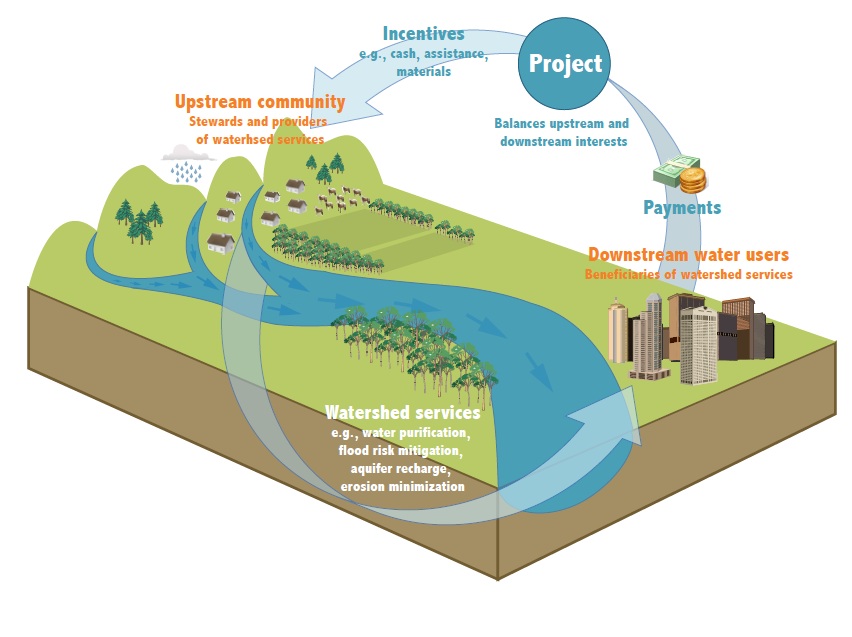Reposted from Huffington Post, originally published 10/10/13
 By Karen Corey, MSEP/MI ’13, Program Assistant for Forest Trends
By Karen Corey, MSEP/MI ’13, Program Assistant for Forest Trends
Four years ago, Kenyan farmer Chege Mwangi was a desperate man. Climate change had thrown off the timing of his harvests, and torrential rains were washing his topsoil into Lake Naivasha — where flower-growers were suffering, too. Sediment from thousands of farms like Mwangi’s was choking off their supply of fresh water. It was an ugly situation — bad for the farmers, bad for the flower-growers, and bad for nature.
We shouldn’t be surprised. Throughout human history, access to safe drinking water has been the exception, not the rule. Worldwide, 783 million people still wake up each morning not knowing where their water will come from that day, and women and girls will collectively spend 152 million hours per day collecting water for use in drinking, washing, and cooking.
Efforts to help cash-strapped regions meet their water needs have generally employed two methods: privatization and charitable aid. The approaches are polar opposites from each other, and neither of them has worked.
The Privatization Fail
The privatization logic works like this: cash-strapped cities dealing with aging infrastructure can sell off leaking pipes and failing water treatment plants, transferring the risk and returns of development to private sector companies better able to leverage investment capital. In theory, privatization leads to more reliable supply as companies upgrade the infrastructure they purchase.
In practice, privatization has tripled the price of water in some places, slashed quality, and stoked corruption. Most importantly, it takes control of water away from local governments and puts it into the hands of faceless corporations, which can disempower communities. Community opposition to water privatization most famously has led to the water uprisings in Cochabamba, Bolivia, where residents protested against Bechtel’s monopoly on the water supply, which extended even to restrictions on rainwater harvesting. The evils of water privatization have even become the concern of James Bond in the person of Dominic Greene, the villain in Quantum of Solace, who seeks to gain control of the entire South American water supply.
The Charity Fail
On the other side of the coin, charitable work has focused on providing pumps and taps to communities isolated from existing water infrastructure — a seemingly meaningful measure that’s little more than a feel-good gesture if the people getting pumps don’t have the funds or expertise to maintain them. These communities return to gathering water from far-off places or contaminated rivers, and estimates say that 30-60 percent of this infrastructure is no longer functional within two years after installation.
As with privatization, the imposition of a solution from outside (even a free one) limits the empowerment and commitment within local communities to find their own solutions. As a result, prominent water, sanitation, and hygiene (WASH) funders have faced a dilemma: how to provide the clean water all humans have a right to, while also enabling economic development and individual empowerment within communities?
The Water Initiative Approach
Fortunately for Mwangi and poor farmers around the world, there is a third approach — one that is quietly delivering water, autonomy, and security to people around the world as the focus shifts away from simply providing drinking water and sanitation to a more holistic approach that takes into account the ecosystem that supports water quality and quantity, as well as the economic factors that impact that quality. In Mwangi’s case, for example, the flower growers along the shores of Lake Naivasha helped him and his neighbors develop sustainable farming practices that reduced runoff and boosted yields — and at a cost of just $20 per farmer.
It’s not charity, but it’s not privatization, either. It’s somewhere in the middle, and it’s a simple model that’s being implemented in African cities like Dar es Salaam, Latin American cities like Heredia, Costa Rica, and North American cities like Denver. Our research shows that more than $8 billion was spent on these sorts of programs in 2011 alone — generating benefits many times that amount.
These projects, termed “investments in watershed services” (IWS), benefit both the downstream users, who get higher quality water, and the upstream land owners, who get access to an additional source of income, reducing their risk and sometimes even improving their crop yields. Graphically, it looks something like this:

The most famous example is New York City’s ongoing investment in the Catskill Mountains, which pays for riverbank protection and maintenance that have allowed NYC to save billions on costly filtration plants. In England, the farmers who participate in Upstream Thinking, a project of South West Water, have turned their farms into mini-water treatment plants — with stream water cleaner after passing through the farm. Urban residents recognize the value of this water — and are willing to pay for it, as demonstrated by the 40,980 residents of Saltillo, Mexico who voluntarily pay a water fee each month to support farmers upstream.
How You can Help
Programs like these are being implemented and tested by scores of organizations around the world. For them to truly deliver on their potential, developers have to know what works, what doesn’t and why. Forest Trends helps deliver that understanding through ourKatoomba Meetings in Ghana, Tanzania, Vietnam, China, and elsewhere, as well as through our Ecosytem Marketplace initiative, and our own pilot projects. We’ve recently partnered with the Swiss Agency for Development Cooperation and local partners in six countries to figure out the best way to use IWS for securing the human right to water, and the Skoll Foundation has invited us to participate in the Social Entrepreneurs Challenge, which it launched on September 30 in cooperation with Huffington Post. You can help by participating in our CrowdRise campaign.
Remember every little bit helps. Just $20 helped Chege Mwangi turn his troubled piece of land into a thriving farm that’s putting his kids through school — but there are thousands like him. You can help by supporting our work here.
by Karen Corey
Program Assistant, Forest Trends Water Initiative
Follow Forest Trends on Twitter: www.twitter.com/EcoMarketplace
